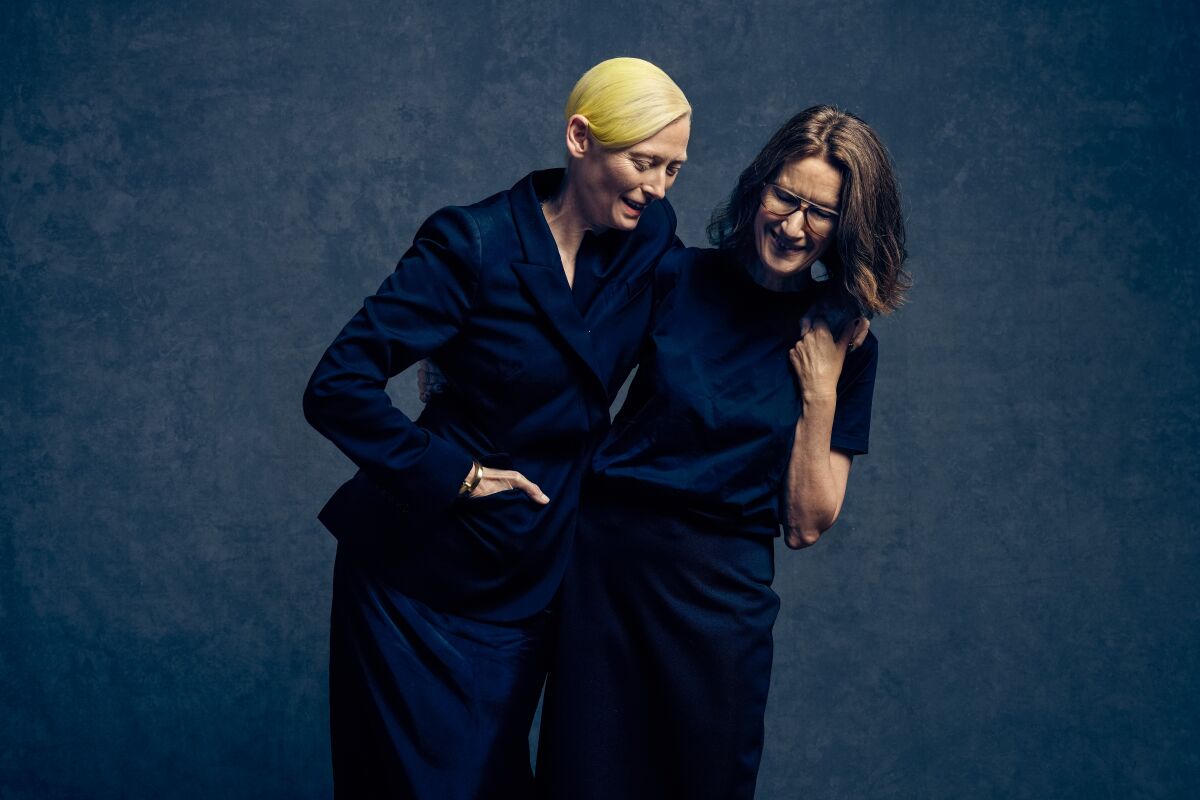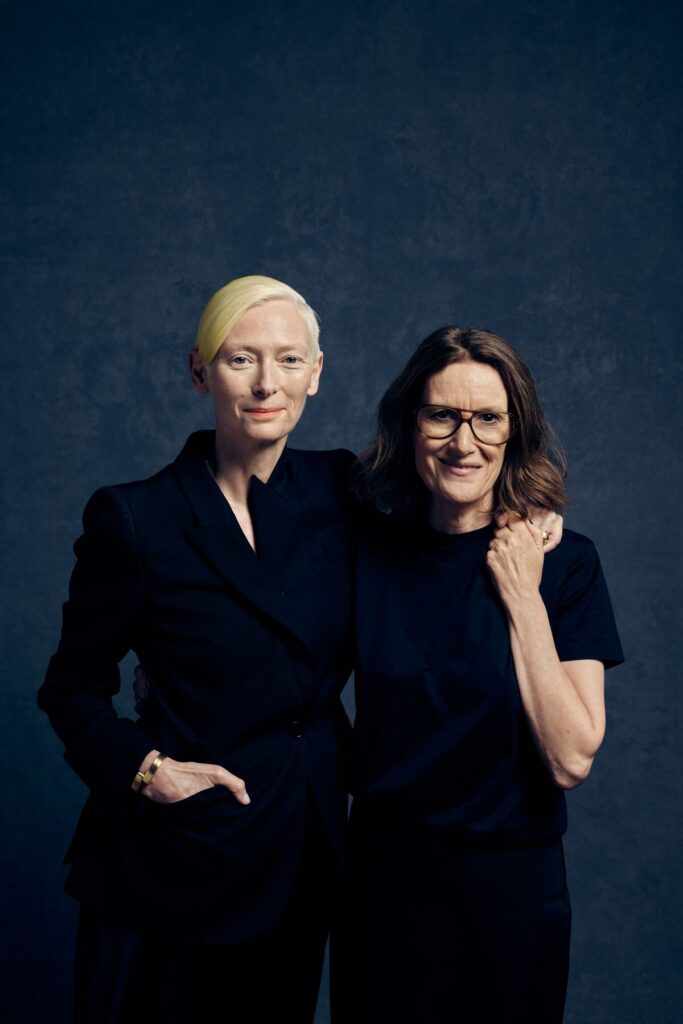Kindred spirits since childhood, actor Tilda Swinton and writer-director Joanna Hogg have just in the last few years realized their long-held desire to collaborate on feature films.
Their latest joint creative endeavor, “The Eternal Daughter,” out in theaters and VOD Friday, is an eerie ghost story about a mother and daughter — both played by Swinton — unspooling their past and present preoccupations inside the walls of an empty hotel.
That both Swinton and Hogg have a clear memory of when they first met back in 1971, as pupils at the West Heath Girls’ School, comes as no surprise given the significance this friendship holds for them. The two were placed in the same dormitory, and magic ensued.
“We looked across the room, and there we were. That was it. We haven’t really moved on since then,” Swinton told The Times in a recent video call. “I was 10 and Joanna was 11.”
For Hogg, who thinks of Swinton as a “soul mate” in life and art, there was comfort in having an ally at a boarding school that didn’t much welcome their personalities. In those early years of this inseparable union, however, neither could foresee cinema as a shared path.
“Even though we never spoke about being storytellers when we were children, we had this bond as observers from the very beginning,” explained Swinton. “We were both alienated from the school we were in and from the groups we were supposed to be a part of.”
After leaving West Heath, Swinton and Hogg went their separate ways into young adulthood. The former attended the University of Cambridge to study social and political sciences, while Hogg first worked as a still photographer’s assistant before gaining acceptance into the National Film and Television School near London.
Though they were always in touch, it was Hogg’s 1986 thesis film, “Caprice,” that presented them with their first chance at artistic partnership. Swinton had acted in stage plays in college, but the student production marked her first time in front of a camera.
Tilda Swinton, left, and director Joanna Hogg.
(Kent Nishimura / Los Angeles Times)
“All roads started with Joanna,” the Oscar-winning Swinton noted. “The relationship and trust with her got me into the drug of working closely in collaboration with filmmakers.”
“Caprice” followed an everyday girl, Lucky (Swinton), on a labyrinthine adventure inside the pages of a fashion magazine. “It felt like we were making ‘New York, New York,’” recalled Swinton, who was impressed with Hogg’s ambition even as an emerging talent. Thematically, the whimsical short closely related to the lives of both novice creators.
“Even if it seems like a total fantasy, it was actually based very much on feelings of insecurity that we both felt at the time, maybe in different ways, about the pressure to look a certain way and be a certain way as a young woman,” said Hogg on the same video call.
A clear homage to “Caprice” features in Hogg’s intimate epic “The Souvenir Part II.”
Swinton went on to work extensively with the late filmmaker Derek Jarman, until she left London in the late 1990s to raise her children in the north of Scotland. Meanwhile, Hogg cut her directorial teeth on British television. For several years, as their personal lives and respective careers inevitably took their courses, they didn’t see much of each other.
“I kind of assumed that we’d work together at some point, but I didn’t know how and when, that was less clear,” said Swinton. “But I did have faith.”
“Unrelated,” Hogg’s debut feature, starring a then-fresh-faced Tom Hiddleston, premiered in 2007 — the same year as “Michael Clayton,” the lauded thriller for which Swinton won an Academy Award for supporting actress. The chameleonic actress remembers a vivid sense of pride upon learning that her friend had emerged into the filmic landscape.
“It was so sharp and so painful, and the temperature of it was so unique, clearly the birth of a new voice in cinema, as we now know,” said Swinton. “[‘Unrelated’] is a bit of a masterpiece for me.”
As Hogg honed her craft with “Archipelago” and “Exhibition,” she admits that for a long time she hesitated to inquire about Swinton’s interest in appearing in one of her projects.
“Tilda was doing very big films, and I was doing really tiny ones. I occasionally thought, ‘Gosh, how will Tilda work in my little band of nonactors? Will her presence be too strong and somehow tip this thing off balance?’” expressed Hogg.
“That was a misapprehension on your part,” Swinton tells Hogg, “because [independent cinema] was my home patch too. I’d just gone off on an adventure following a trail through the forest into all sorts of places like Hollywood. But I was always longing to get back to it.”
From this period apart, Hogg’s two favorite Swinton performances exist in “Julia,” the portrait of an alcoholic, and her hilarious turn in “Burn After Reading.” Of the numerous ventures the two hope to tackle together in the future, a comedy stands high on the list.
The long-awaited opportunity for cinematic communion finally materialized with Hogg’s semiautobiographical, two-part masterwork: “The Souvenir” and “The Souvenir Part II.”
In both chapters, Swinton embodies an upper-class, white-haired lady named Rosalind, an avatar for Hogg’s mother. The story, however, centers on Julie, a self-conscious film student in the 1980s. The first installment sees her involved in a self-destructive love affair, from which she recovers in the second piece as she also asserts her artistic sensibilities.
While we discussed “The Souvenir,” an inquisitive Swinton asked Hogg why she eventually overcame her trepidation about the actor fitting back into a humbler production and offered her the role of Rosalind. “You knew the story in a very personal way,” Hogg replied.
In turn, Swinton found the task a chance to, as she put it, “chew one’s own cud.”
“To play a woman like Rosalind is a very personal business for me, because I am the daughter of a woman like that. It’s an opportunity to marinate, fantasize and try and figure out my relationship to her,” explained Swinton. “It’s more than just a part in a film, even a part in one’s friend’s film playing someone quite close to her mother.”
Aware of Hogg’s unfruitful search for an unmannered young woman without formal acting training to bring Julie to life, Swinton, against her own maternal concerns about exposing her children to her profession, suggested her own daughter, Honor Swinton Byrne, then 19 and about to travel to Africa to be a volunteer teacher, as an ideal candidate.
Though Hogg initially hesitated in casting the teenager, the end result validated Swinton’s proposition. As if the meta layers derived from the Swintons not only playing mother and daughter onscreen, but characters inspired by Hogg and her own mother, weren’t sufficiently complex, the director and Swinton Byrne also share a deeper personal bond.
“I wasn’t the godmother from her birth,” said Hogg. “I was chosen to be her godmother by Honor when she was an adult.”
Curiously, Hogg didn’t create a direct stand-in for Swinton in the “Souvenir” films. In the fiction, Julie has plenty of acquaintances but not a close confidant that truthfully illustrates how instrumental Hogg and Swinton were for one another at that age.
“I wasn’t trying to get the essence of our friendship because that would’ve been a film in itself,” said Hogg. “That relationship that Tilda and I had is so specific and so particular, I couldn’t begin to try and depict that.”
A spiritual continuation of the “Souvenir” films, “The Eternal Daughter” brings back Julie, now older, and Rosalind. Neither Hogg nor Swinton could let go of them, especially of Rosalind. They were mutually invested in exploring her inner life further.
In Hogg’s account, it was Swinton who suggested she could play both characters. And though the performer isn’t certain who brought it up first, she agrees that such a proposition only came to pass because of their creative synchronicity.
“This may sound like a flippant thing to say, but the decision for me to inhabit both Rosalind and Julie is such a preposterous idea in the first place, the fact that we both just stepped into it was like two children in a sandbox,” Swinton said with a smile.

Tilda Swinton, left, and director Joanna Hogg.
(Kent Nishimura / Los Angeles Times)
Despite having conceived the “Souvenir” duology, there was a sense of newness in the making of “The Eternal Daughter” because Hogg was trying her hand at genre, and the subject matter provided room for catharsis. Through the process of creation, and the deepening of their fraternal love, Hogg and Swinton grappled with their mothers’ deaths.
“We both expressed when we were shooting it that it felt like our first film. And that statement is very profound,” said Swinton. “Joanna and I are beginning our work. We’ve been very slowly tiptoeing our way towards for 50 years.”
The basis for their mutual understanding is extensive discussions, from the philosophical to the mundane, that have constantly been revisited. “It’s not like we’ve moved on to new topics,” said Swinton. “We’ve been talking about our mothers and our relationships with our mothers and the mysteries of our mothers since we were 10 and 11.”
But talking about ideas quickly proves insufficient. They must incarnate and be explored through storytelling in pursuit of a revelation, chiefly for their own enlightenment.
“The fact that other people might be interested is, I’m ashamed to say, slightly secondary in importance,” added Swinton. “It’s the fact that it might enlighten us and increase our understanding and our reflected lives.”
Enamored with her friend’s unconventional narrative tactics to reach her desired emotional destination, Swinton describes Hogg’s nuanced approach, which is difficult for the director to articulate herself, as being asked to conjure a portrait of a person. Hogg provides a scrupulous framework for the story, yet doesn’t have rigid expectations for the dialogue.
There’s no memorization of lines or mannerisms, but an active search for the character’s personality and voice from within the actor on set. That’s why Rosalind’s presence feels lived-in, Swinton thinks.
“It’s about uncovering and recognizing, but it can only be done in the moment that we are working. And that’s why I can’t catch that in the writing,” explained Hogg. “It’s got to be done live, in that moment I’m all ears and eyes.”
Asked if a distinction exists between the professional and the personal, the pair concurred that the multiple facets they play in each other’s worlds are by now completely enmeshed.
“You could either say that the working relationship is based on the kinship or that the kinship is fed by the work as well,” Swinton said. “If for some crazy reason we weren’t able to go on making work together, I know we’d go on having these conversations.”
“I can’t separate the two, given the way that we worked together on these three films,” said Hogg. “It’s all one conversation. It’s all one relationship.”
Sisters in cinema for over half a century, both Hogg and Swinton believe that molding work out of the material of their shared experiences came naturally. And though they appreciate how miraculous it has been to encounter a lifelong accomplice, neither is ready to give in to nostalgia. Even if a movie about their dreaded days at boarding school is off the table, they have plans to turn more of their ongoing conversations into fascinating visions.
“Maybe when we’re in our 90s, we’ll look back and say, ‘How incredible it is that all these things coexisted and our lives paralleled in the ways that they have,’” said Hogg. “But right now we are looking forward, if anything, but not so much looking back.”
“We’re making up for lost time,” said Swinton.

